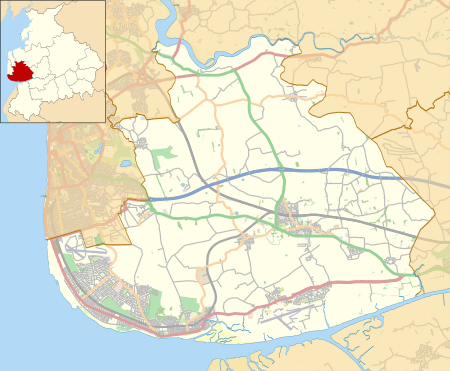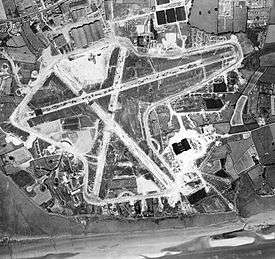Warton Aerodrome
| Warton Aerodrome | |||||||||||
|---|---|---|---|---|---|---|---|---|---|---|---|
|
Aerial photograph of Warton airfield, the main runway runs NE/SW, hangars and technical buildings are to the southeast, 10 August 1945. | |||||||||||
| IATA: WRT – ICAO: EGNO | |||||||||||
| Summary | |||||||||||
| Airport type | Private | ||||||||||
| Owner/Operator | BAE Systems | ||||||||||
| Location | Preston | ||||||||||
| Elevation AMSL | 55 ft / 17 m | ||||||||||
| Coordinates | 53°44′42″N 002°53′02″W / 53.74500°N 2.88389°WCoordinates: 53°44′42″N 002°53′02″W / 53.74500°N 2.88389°W | ||||||||||
| Map | |||||||||||
 EGNO Location in the Borough of Fylde | |||||||||||
| Runways | |||||||||||
| |||||||||||
Warton Aerodrome (IATA: WRT, ICAO: EGNO) is located near to Warton village on the Fylde in Lancashire, England. The aerodrome is 6 NM (11 km; 6.9 mi) west of Preston, Lancashire, UK.
Today the airfield is a major assembly and testing facility of BAE Systems Military Air & Information. It is also part of Lancashire Enterprise Zone.
Warton Aerodrome has a CAA Ordinary Licence (Number P748) that allows flights for the public transport of passengers or for flying instruction as authorised by the licensee (BAE Systems (Operations) Limited).[2]
History
Establishment and military use
In 1940 new runways were built at Warton so that it could act as a "satellite" airfield for the RAF Coastal Command station at Squires Gate airfield in Blackpool.[3]
The airfield was first operated as an air depot of the United States Army Air Forces (USAAF) during World War II, as thousands of aircraft were processed on their way to active service in Britain, North Africa, the Mediterranean and mainland Europe. On 14 August 1944 Glenn Miller, recently promoted to the rank of major, played a concert to 10,000 servicemen on a platform erected in front of No. 4 Hangar.[4] On 23 August 1944, the accidental crash of a USAAF Consolidated B-24 Liberator heavy bomber caused the Freckleton Air Disaster.[5]
It then became a Royal Air Force station.
Aircraft manufacturers

In 1947, English Electric took over the site, moving its main design office there from the Strand Road site in Preston in 1948.
With the merger of English Electric Aviation and the other aircraft divisions of the major British manufacturers in 1960, it became a British Aircraft Corporation (BAC) site. BAC was then nationalised and merged with Hawker Siddeley and Scottish Aviation to form British Aerospace (BAe) in 1977. BAe was later privatised in 1981 and was renamed BAE Systems in 1999. As such the airfield has been the testing ground for several frontline aircraft including the English Electric Canberra, the English Electric Lightning, the BAC TSR-2, the Sepecat Jaguar, the Panavia Tornado, the BAE Hawk (formerly the Hawker Siddeley Hawk) and most recently the Eurofighter Typhoon.
In June 2010 The Sun reported that poisonous red back spiders had been discovered in a consignment of parts from Australia. The article expressed fears that these spiders would colonise the surrounding countryside.[6] As a routine response, BAE Systems employed a specialist contractor who quickly managed to eliminate the spiders. The contractors were assisted by the fact that the Australian red back spider has very visible nests, a relatively short two-week gestation period, a reluctance to wander from its nest, and an intolerance to the British climate except at the height of summer. BAE Systems also implemented a number of measures to prevent further incursions of foreign species in subsequent consignments from Australia.
Development
Eurofighter
Warton was used as the base for all British development aircraft (DA) and Instrumented Production Aircraft (IPA) in the Eurofighter programme. Warton has been home to the initial Typhoon squadrons of the Royal Air Force, No. 17 Squadron and No. 29 Squadron. This was under the so-called "Case White" programme where BAE assumes more responsibility for training and support of the new aircraft than previous RAF types which were introduced under a more "in house" system. BAE states that this allows inevitable problems with any new aircraft to be quickly ironed out by BAE personnel on site. BAE plans to offer this on site service to any export customers.
Nimrod
Warton was also used for development flying of the Nimrod MRA4 Maritime Reconnaissance and Attack aircraft until the aircraft was cut in the Strategic Defence and Security Review in 2010.
Production
Tornado
The final new build Tornado left Warton in 1998, a GR.1 for Saudi Arabia. Following this the main assembly hall was re-fitted as the final assembly site of the Eurofighter Typhoon. BAE estimate that modern manufacturing techniques will allow the 30 week assembly time for a Tornado to be reduced to 16 weeks for the Typhoon.
Private airfield


Warton is the base for BAE Systems' Corporate Air Travel department which operates scheduled services for employees (and those of partner organisations) to Farnborough, Munich, Filton, Cambridge, RAF Coningsby, and RAF Marham. The Farnborough and Munich services are provided by Corporate Air Travel's BAe 146 aircraft, with the others contracted out to other operators. Many ad hoc passenger flights also take place operated by various VIP operators including the Queen's Flight.
The site is not open to the public. For many years limited areas were made accessible during open days, on a four-yearly cycle alternating with Samlesbury, which the company held for the families and friends of employees and local residents. These "Families' Days" were free of charge and typically included demonstrations of activities, tours of simulation facilities and impressive flying displays. The last Families' Day was held in 2006.[7]
Police helicopter
From November 1994, the Lancashire Constabulary operated a Eurocopter AS355 helicopter stationed at Warton. Later, it was replaced by a newer more capable EC135.
Enterprise zone
Since 2012, the aerodrome has provided one of the two sites of Lancashire Enterprise Zone, the other site being at BAE Systems' Samlesbury Aerodrome.[8] The zone's site at Warton covers 72 hectares (180 acres).[9] BAE Systems, Lancashire County Council and Lancashire Enterprise Partnership coordinate the site's development.[8]
References
- ↑ Warton - EGNO
- ↑ Civil Aviation Authority Aerodrome Ordinary Licences
- ↑ Lancashire County Council: Lancashire Profile
- ↑
- ↑ Turner, Joyce (2007). The Freckleton Tragedy, 1944. Blackpool, UK: Landy Publishing. ASIN B0013VRN3W. ISBN 978-1-872895-77-2.
- ↑ Deadly invasion of Oz spiders at thesun.co.uk
- ↑
- 1 2 Dillon, Jonathon (26 February 2012). "'Big companies' interested in East Lancashire enterprise zone". Lancashire Telegraph. Retrieved 26 March 2015.
- ↑ Woodhouse, Lisa (23 August 2012). "Lancashire enterprize zone due in to boost jobs 18 months". Lancashire Telegraph. Retrieved 26 March 2015.
External links
Video clips
- British Aerospace 1980s promotional video
- Apprentice at Warton with Eurofighter assembly in March 2010
